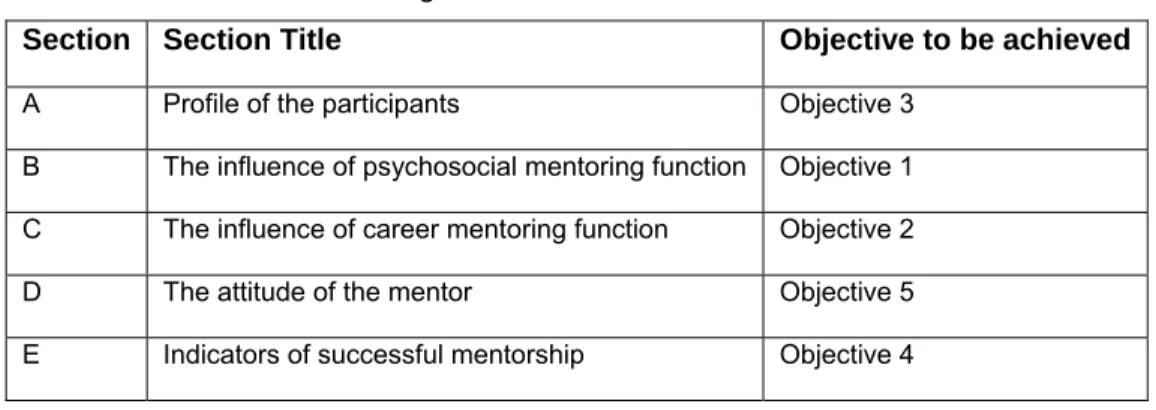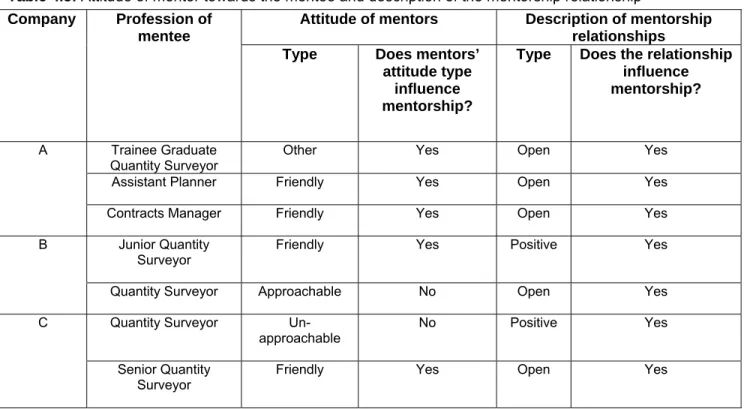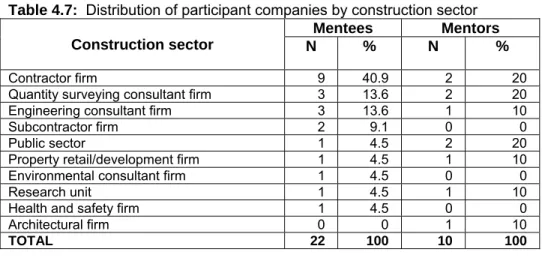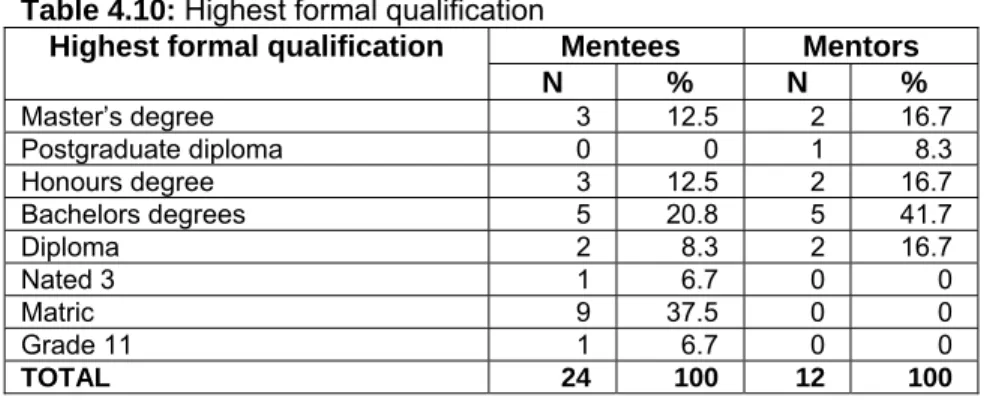109 TABLE 4.59: TEST STATISTICS ON KNOWLEDGE GAIN IN THE AGE GROUPS OF FEMALE STUDENTS. 111 TABLE 4.63: TEST STATISTICS ON KNOWLEDGE GAIN IN THE AGE GROUPS OF FEMALE STUDENTS.
INTRODUCTION
BACKGROUND OF THE PROBLEM STATEMENT
Blake-Beard advises that the supervisor should be involved in the mentee and mentor relationship to prevent such situations from developing. Consequently, impeding factors of mentoring of women have led to poor performance, slow career progression, lack of entrepreneurial abilities and poor retention of women in the construction industry in South Africa (Hansman,.
PROBLEM STATEMENT
RESEARCH QUESTION
AIM
OBJECTIVES
HYPOTHESES
SIGNIFICANCE OF THE STUDY
RESEARCH METHODOLOGY
Content analysis was used as a detailed and systematic approach to qualitative data analysis of the content of a particular body of material with the aim of identifying patterns, themes or biases (Leedy & Ormrod Maree, 2007:101). Descriptive statistics describes the body of data that has been collected (Leedy & Ormrod, 2010:257).
LIMITATIONS
ASSUMPTIONS
ETHICAL STATEMENT
CHAPTER OUTLINE
Furthermore, the following are addressed: indicators of successful mentoring, mentoring functions and impact of demographics of mentors and mentees in successful mentoring. The areas covered in the main study include: the response rate, the profile of respondents and indicators of successful mentoring of female mentees.
INTRODUCTION
WOMEN EMPOWERMENT PROGRAMMES IN THE CONSTRUCTION INDUSTRY
International empowerment of women in the construction industry
- Leading women of Africa
- National Association of Women in Construction
The National Association of Women in Construction (NAWIC) is an international organization founded in Texas in 1952 (NAWIC, 2012:online). Women are mentored to advance in their careers, receive scholarships and women entrepreneurs receive financial support (NAWIC, 2012:online).
Empowerment of women in the South African construction industry
South African Women Entrepreneurship Network (SAWEN), under the Department of Trade and Industry (DTI), empowers women from rural areas and disadvantaged backgrounds who want to set up their own businesses (DTI, 2012:online). They are encouraged to enter, establish and ensure their retention in the industry (DTI, 2012:online).
MENTORING FUNCTIONS
Psychosocial mentoring
- Role modelling
- Acceptance-and-confirmation
- Counselling
- Friendship
As the mentee's competence advances in the workplace, the mentor's acceptance and affirmation provides support and encouragement (Kram, 1985:35). Friendship makes the mentee begin to mature and feel like a peer of the mentor (Kram, 1985:36).
Career mentoring
- Exposure
- Sponsoring
- Coaching
- Protection
- Challenging tasks
Future opportunities, such as promotions, come when the mentee is under the guidance and support of the mentor (Vanderbilt, 2010: 12). The mentor usually does this by examining the mentee's behavior (National Association of Secondary School Principals, 2007: online).
THE INFLUENCE OF THE AGE, GENDER AND RACE OF THE MENTOR‐MENTEE RELATIONSHIP ON A SUCCESSFUL
- Gender
- Gender versus type of mentoring provided
- Gender versus mentoring opportunities
- Mentorship relationships
- Race and ethnicity
- Cross-race mentorship
- Same-race mentorship
- The influence of age on the successful mentorship of women
- Mentees and mentors with similar ages
- Benefits of multiple mentors
The quality of learning and development depends on the quality of the mentorship relationship (Klasen & Clutterbuck, 2002: 118). The same-age mentor relationship was challenged by the mentor's knowledge and skills and relationship boundary issues (Finkelstein et al., 2003 cited in Deering, 2010:13).
MENTOR ATTITUDES AND THEIR EFFECT ON SUCCESSFUL MENTORSHIP
- Patience
- Friendliness
- Stereotyping
- Bias
- Prejudice
As a result, those who fall in the middle or on the wrong side of the continuum are believed to be unstable and need help (Edwards & Spence, 1987:146). Moreover, it is caused by a misinterpretation of the social and economic issues in the lives of women and men (Murray, 1994: 185).
NATURE OF MENTORING RELATIONSHIPS
Informal and formal mentoring
Klasen and Clutterbuck believe that women have less access to potential mentors because potential mentors are unwilling to mentor women and women do not want to be misinterpreted as wanting sexual advances when approaching male mentors to mentor them. Ragins and Cotton conducted a comparative study of men and women in formal and informal mentoring relationships.
Phases of mentorship
- Initiation phase
- Cultivation phase
- Separation phase
- Redefinition phase
The mentor builds the self-confidence of the mentee by providing challenging assignments that will expose the mentee (Steinmann and the mentee become more independent (Kram, 1983:618). Steinmann (2006:5) suggests that regardless of the duration of the mentoring relationship, the process goes through four overlapping phases.
INDICATORS OF SUCCESSFUL MENTORSHP OF WOMEN
- Increased productivity
- Increased knowledge
- Task
- Role
- Group
- Organisation
- Career advancement
- Job position
- Promotion on the job
- Performance
- Earnings
- Entrepreneurial skills
- Work tenure of women
The purpose of having mentoring relationships in organizations is to increase knowledge of the mentee and improve the mentee's performance in the organization (Kahle-Piasecki, 2011:48). Socialization in organizations is one of the key factors influencing employee retention (Bauer, Morrison & Callister promotes positive organizational attitudes such as job satisfaction and organizational commitment (Griffeth, Hom & Gaertner, 2000:483).
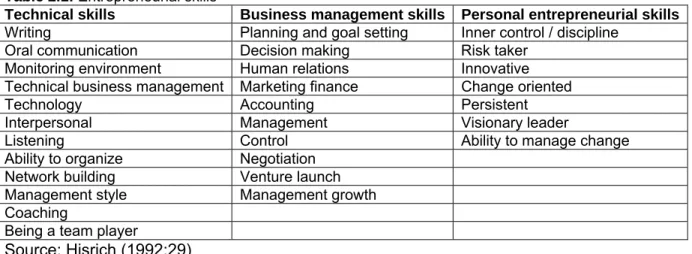
CHAPTER SUMMARY
The authors argue that women lack these skills and that businesses lacking these skills are often the cause of failure in South Africa. Employees use the skills, knowledge and experience they acquire at the workplace in their companies.
INTRODUCTION
RESEARCH APPROACH
Quantitative approach
Qualitative approach
For example, when the answer is 'yes', 'no', 'agree' or 'disagree', respondents are asked to explain their answer or their feeling towards the answer (Naoum, 2007:56). Female mentor participants reported that they would mostly leave a specific organization because they have learned enough from that organization and need to learn something new (39.1%) The second reason why they would leave was because they are not satisfied with their salary (34.8 %).
RESEARCH STRATEGY
Case study
Survey study
AREA OF THE STUDY
POPULATION OF THE STUDY
SAMPLING TECHNIQUE AND SAMPLE SIZE
Sample size depends on many different considerations, which include population size and population homogeneity (Fox & Bayat, 2007:60). According to Statistics South Africa, the female population size in the construction industry was 141, while the male population size was 920 (Statistics South Africa, 2013:15).
DATA COLLECTION METHOD
Primary data collection method
In addition, Fox and Bayat (2007:60) stated that it also depends on the degree of reliability needed in the investigation and on the method of sampling that is used. Gay and Airasian stated that the entire population should be surveyed if the population is around 100, and 50% should be surveyed if the population is around 500.
Secondary sources of information
TECHNIQUES FOR DATA COLLECTION
Questionnaires
Section Section Title Objectives to be achieved A Profile of the participants Objective 3 B The influence of the psychosocial mentoring function Objective 1.
Interview protocol
In Section E, questions were asked to determine whether the demographics of the mentor-mentee relationship influenced the successful mentoring of women. Section G questions whether the attitude of the mentor towards the mentee has a positive impact on the successful mentoring of women.
DATA ANALYSIS METHOD
Descriptive statistics
This process was continued using methods for calculating numerical descriptions of data (Dominowski, 1980:141). Measures of dispersion provide an idea of the spread of a set of points over a scale (Dominowski, 1980:148).
Inferential statistics
If there is an even number of values, the median is usually the average of the middle two values (Goddard & Mellville, 2001:52). The standard deviation is the positive square root of the variance; the population standard deviation is denoted by σ (Mellville and Goddard, 2001:53).
Content analysis
The inferential statistical techniques used in this study were the Kruskal-Wallis test and the analysis of variance test (Anova). The Kruskal-Wallis test contains a chi-squared value, a degree of freedom (df), and a significance level (Asymp. Sig).
RELIABILITY
The split-half approach is a combination of the equivalent form method, where both tests, the original and the equivalent form, are combined into one (Field, 2013:708). Goddard and Mellville explained that the two questions were differently worded versions of the same question without respondents realizing that this was the case.
VALIDITY
The Cronbach's Alpha (α), an index used to objectively measure the reliability of a questionnaire instrument, was used to test the consistency of the collected data (Girden and Kabacoff, 2011:381).
CHAPTER SUMMARY
In the main study, a quantitative approach was used to test the study hypotheses.
INTRODUCTION
ANALYSIS OF THE PILOT STUDY
- Analysis of company A – parastatal firm
- Profile of company A
- Preparation of interview
- Profiles of company A participants
- Analysis of company B – Contractor firm
- Profile of company B
- Preparation of interview
- Junior quantity surveyor and quantity surveyor interview
- Analysis of company C ‐ quantity surveying firm
- Profile of company C
- Preparation of interview
- Quantity surveyor and senior quantity surveyor interview
- Indicators of successful mentorship
- Indicators of successful mentorship: Company A
- Indicators of successful mentorship: Company B
- Indicators of successful mentorship: Company C
- Profiles and indicators of successful mentorship of female mentees
- Psychosocial mentorship function
- Career mentorship function
- The impact of the age, gender and race on the mentor‐mentee relationship
- The impact of the age, gender and race on the mentor-mentee relationship in Company A 65
- The impact of the age, gender and race on the mentor-mentee relationship in Company C 67
- The impact of the mentor‐mentee relationship on the successful mentorship of female mentees68
- The impact of the mentor-mentee relationship on the successful mentorship of female mentees
- The impact of the mentor-mentee relationship on the successful mentorship of female mentees
- Mentor attitude towards the mentorship of female mentees
- Attitude of mentors towards the mentorship of women: Company A
- Attitude of mentors towards the mentorship of women: Company B
- Attitude of mentors towards the mentorship of women in Company C
- Attitude of mentors towards female mentees’ mentorship
The gender and race of the junior quantifier's mentor does not stand in the way of the success of the mentorship. The quantity researcher revealed that the mentor's age, gender and race does not preclude the success of the mentorship she received.
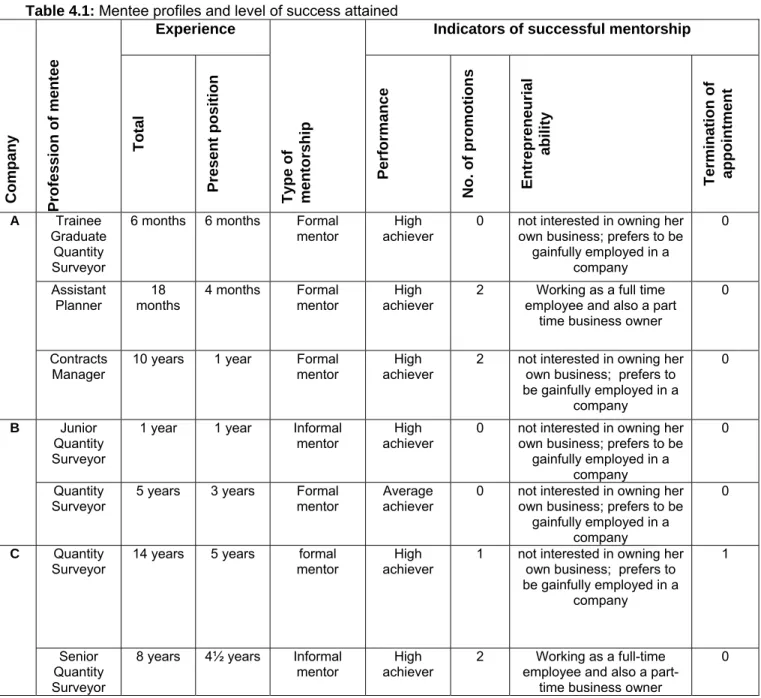
ANALYSIS OF THE MAIN STUDY
Response rate of questionnaire surveys
Profile of respondents
- Participant companies
- Distribution of female mentees and mentors by age
- Distribution of mentees and mentors by race
- Formal qualification of mentees and mentors
- Experience of mentees and mentors
- Positions of mentees and mentors
- Women who are in mentorship relationship
- Types mentorship of provided
- Working in the same organisation with the mentor or mentee
- Mentees working with their mentors in the same industry
- Length of mentoring
- Gender of mentors
Table 4.11 shows the years of experience of the mentee participants in construction. The distribution of the mentor of the mentees and the mentee of the mentors by age group is shown in Table 4.18.
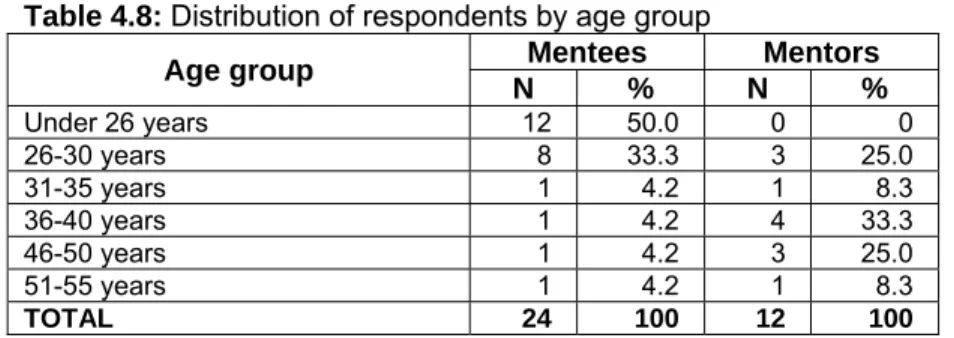
Test of normality
Reliability testing
Indicators of the success of a mentorship programme
- Career development
- Entrepreneurial skills
- Gain of knowledge
- Increased productivity of female mentees
- Work tenure of women
This indicates that most mentors are interested in the development and growth of mentees. Most of the mentors believe that their mentees would like to continue working in their organization.

The attitude of mentors towards their mentees
- Mentor attitude towards mentees and its influence on the mentorship of women
- Attitude of mentors towards the mentorship programme
- Attitude of mentors influencing attitude of mentees
- Descriptive statistics of attitude of mentors towards female mentees
The study aimed to determine whether the attitude of mentors affects the attitude of mentees. The results suggest that the majority of mentee participants consider their mentors' attitude towards their successful mentorship as friendly.

Psychosocial mentoring function of women
- Descriptive statistics of psychosocial mentoring function
The most influential function in psychosocial mentoring was role modeling (mean of 3.82) followed by counseling (mean of 3.54) and acceptance and affirmation (mean of 3.52). Mentors noted that they provided the psychosocial mentoring function to their female mentees with an overall mean of 3.37.
Career mentoring function of women
- Descriptive statistics of career mentoring function
From Table 4.45, the mentees' perception of the most influential functions of career mentoring provided to them is as follows: coaching (average 3.69), followed by the provision of challenging duties/tasks (average 3.61). The least influential career mentoring functions were exposure (mean 3.23), sponsoring (mean 3.17) and protection (mean 3.13).
Testing of hypotheses
- Psychosocial mentoring function
- Career mentoring function
- Indicators of successful mentorship of women
- Attitudes of mentors towards the mentorship of female mentees
The findings highlighted that statistically, the influence of age groups of female mentors is not. The ANOVA test is applied to the age groups of the mentored women in relation to the attitude of the mentors.

CHAPTER SUMMARY
Further findings showed that the mentoring performance of women is not affected by the mentors' attitude towards the mentee's age and race. The findings show that the majority of male and female mentors perceive that the attitude of the mentors has a positive effect on the successful mentoring of women.
INTRODUCTION
CONCLUSIONS
- Psychosocial mentoring function
- Career mentoring function
- Age, gender and race of the mentor‐mentee relationship
- Attitude of mentors towards the mentorship of female mentees
- indicators of successful mentorship of women
- Career advancement
- Retention of female mentees
- Gain of knowledge
- Increased productivity
- Entrepreneurial skills
The extent of the influence of the career mentoring function in the successful mentorship of female mentees was investigated. The main study examined the influence of female mentees' age and race on women's successful mentoring.
SUMMARY OF CONCLUSIONS
The main study sought to determine whether the productivity of female mentees is influenced by the successful mentoring they receive at the workplace. It was established that successful mentoring affects the productivity of mentees and that mentees are productive at work.
LIMITATIONS OF THE STUDY
CONTRIBUTION TO THE BODY OF KNOWLEDGE
RECOMMENDATIONS
Education is a powerful weapon for human development, so women should be encouraged to continue their studies and also take short courses. Female students at primary and secondary school level should be exposed to the construction industry and encouraged to enter this field after completing their education.
FURTHER RESEARCH
Please rate the influence of the following psychological factors on the success of your mentoring in the construction industry (1 = low influence, 5 = high influence). Please rate the influence of the following career factors on the success of your mentorship in the construction industry (1 = low influence, 5 = high influence).
